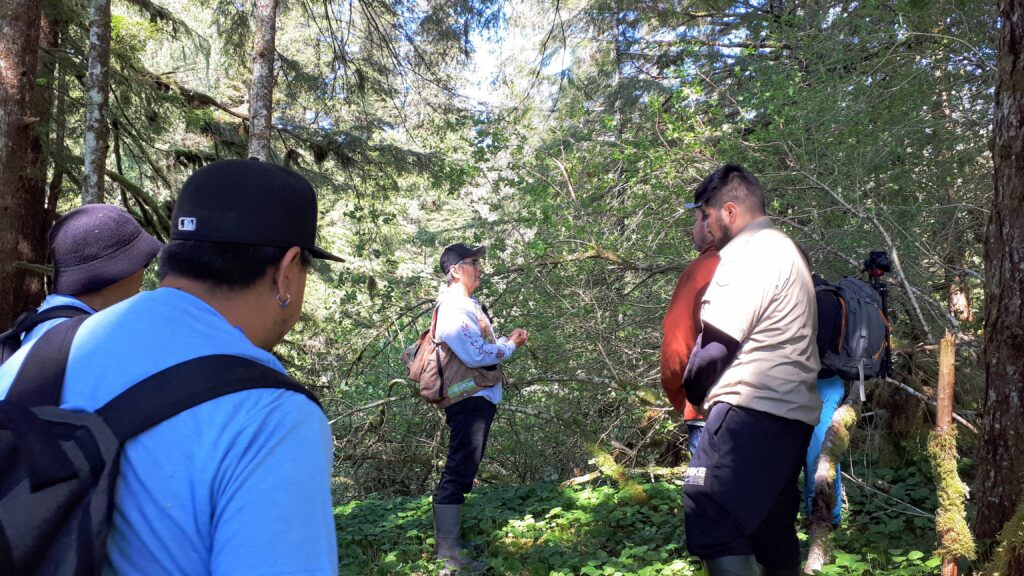At the 2023 Coastal Stewardship Network Annual Gathering (May 15-19), Coastal Guardians from across the North and Central Coast and Haida Gwaii met in person for the first time since 2019, after settling for “virtual” gatherings over the past three years.
Held each year since 2008, the Guardians have always looked forward to the gatherings, which involve a huge amount of sharing, learning, connecting, reconnecting and, most of all, laughter. This event was more highly anticipated than ever—not just because it had been so long since they had met in person, but also because it was the first ever to be held in Haíłzaqv Territory.
After an opening ceremony and dinner at the Gvúkva’áus Haíłzaqv Big House, which included welcome addresses from HIRMD Stewardship Director Kelly Brown and Conservation Manager William Housty, the next few days featured a range of hands-on activities, including visits to cultural sites and important harvesting areas, and an engaging drum making exercise.
On the third day of the gathering, May 17, the Guardians were able to spend a full day with respected archaeologist Q̓íx̌itasu Elroy White, who operates Central Coast Archaeology from his home in Bella Bella.
Q̓íx̌itasu began the day with a presentation, providing some background for the Guardians on his unique “M̓ṇúxvit approach” to archaeology, which unites his Haíłzaqv cultural and ancestral learnings with his professional training as an archaeologist.
“The fact I use a Haíɫzaqv word empowers me… I use our language to help interpret these sites created by my ancestors rather than the English words that tend to lose their meaning,” explained Q̓íx̌itasu, adding that Haíɫzaqv ancestors named those sites that way for a reason. Q̓íx̌itasu says this has been the approach throughout his career. For example, his Master’s thesis at Simon Fraser University—titled Heiltsuk Stone Fish Traps: Products of my Ancestors’ Labour—incorporates Haíɫzaqv political and cultural entities and stories from Haíɫzaqv oral historians, and is as much for his ancestors as it is about them.
During the morning’s presentation, Q̓íx̌itasu highlighted the importance of cultural and ancestral teachings for the Guardians’ stewardship work as well. “Your work is directly tied to your Indigenous laws, so I tip my hat to you guys,” he said. “As Guardians, you all have connections to your local places and territories, and those are ties that external academics just don’t have.”
After some questions from the group, everyone headed out on the Guardian boats to visit important cultural sites, including an old Haíɫzaqv winter village, some rock paintings along the coastline, and an island with several culturally modified trees. Q̓íx̌itasu pointed out where an ancient stone fish trap has existed beneath the coastal waters for thousands of years, a clear example of continuous settlement and fishing ingenuity in the region.
“Drones are a great way to view some of these archeological features,” said Q̓íx̌itasu, whose grandson and drone operator, Gíƛa Keegan Nappie-Edgar, was on hand to demonstrate how drones give them a more expansive view while exploring sites. Gíƛa works closely with Q̓íx̌itasu on the drones and other technical tasks, as well as making connections with youth groups, such as the SEAS (Supporting Emerging Aboriginal Stewards) program in Haíɫzaqv territory.

Importance of Collaboration
All of the day’s activities and topics—including visits to Haíɫzaqv cultural sites, drones and discussions about engaging youth—clearly resonated with the Guardians, who often work with youth and other community members in a wide range of roles that go beyond stewardship.
Q̓íx̌itasu says this kind of holistic approach to the work, whether it’s about archaeology or stewardship, is what makes it far more meaningful and more effective too.
“This is intergenerational work that must be done responsibly,” he tells the Guardians, as they gather in the shade from a massive culturally modified cedar tree. “That’s why it’s so important to collaborate with other Nations as well, and to always be open to learning from each other.”



